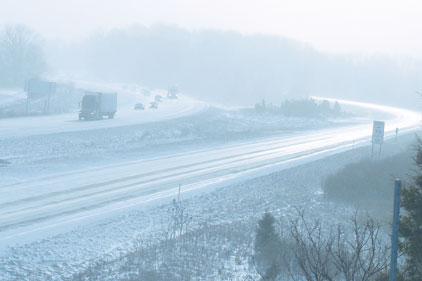Winter driving affects every level of employee within your organization. Whether you manage a fleet of vehicles, oversee a mobile sales force, or employ commuters, you can greatly reduce the risks your employees and their families face by helping them to understand best practices for driving in the winter season.
Prepare your vehicle
Before the snow arrives, winterize your vehicles by scheduling a maintenance check-up that covers: tire condition and air pressure, wiper blades, battery check, belts and hoses, radiator, oil and fluid levels, lights, brakes, the exhaust system, the heater/defroster system, and the ignition system. Besides running well, a car that has all parts working properly will help you see and be seen on the road and maximize your ability to respond effectively to the unexpected. Additionally, commercial vehicles will often require a full pre-trip inspection before hitting the road, which is especially important in less-than-ideal conditions.
Sudden storms, impassable roads, or sliding into a ditch can leave you stranded at the side of the road. Prepare a winter survival kit to keep in the trunk of your vehicle. Include a flashlight, jumper cables, shovel, sand or kitty litter, snow brush and ice scraper, emergency food, and extra warm clothing and footwear. Carrying a cell phone can prove to be life-saving as well; however, use cell phones wisely. Distracted driving has become a severe hazard on the road. Remind employees that their vehicle should be safely stopped prior to making a phone call or sending a text message.
It is important to pay extra attention to vehicle routes and commutes in adverse weather conditions. When road conditions and visibility are poor, either avoid travel or postpone the trip if possible — there are times when waiting a few hours can mean the difference between driving in hazardous conditions or on clean, plowed roads. In areas where winter storms can potentially affect the ability for your site to operate, have a plan in place for days when workers may not be able to travel to work. This plan should include action items in the event of severe weather, a communication plan to alert employees, and backup operations for your site or business.
If vehicles must be driven during inclement weather, plan routes so travel will be on main roads, which are more likely to be plowed, and allow extra time to get to your destination. It’s also a good idea to communicate routes and travel plans to multiple people in case of an emergency.
Know your driving tactics
Training on winter driving skills can help reduce your employees’ potential for an accident. For best results, training should occur before the winter season. Cover the following safe driving tactics in your annual winter driving training session. These points are important for all drivers — even those who only commute to and from work each day — and can be passed along to employees’ family members to ensure their safety as well.
- On the road, stay alert, observant and cautious. According to the Department of Transportation, most winter accidents are the result of driving too fast for the conditions.
- Wintertime requires different driving tactics, as build-up of snow and ice is enough to test any driver’s skill. Harsh braking or sharp steering can cause you to slide on icy roads. Thus, using a smooth, light touch on the controls is paramount to safe winter driving — that means slower speeds, slower acceleration, slower steering and slower braking.
- Keep in mind that the posted speed limit is intended for ideal road conditions, so go slower than the speed limit when roads are covered with ice or snow.
- Roads can become icy and slick whenever temperatures drop below 40 degrees, with certain sections of road being particularly hazardous. Shaded areas, bridges, overpasses and intersections often freeze sooner when it gets cold and stay slippery longer as the temperature rises. Black ice is a prime hazard in these areas, causing roads that look dry to be very slippery. This thin, clear ice can be hard to spot because it takes on the color of the road, which is why black ice is one of winter’s worst hazards. Also, it is important to increase your following distance to account for slippery surfaces.
- If your vehicle breaks down or is stuck, do not panic; either use your cell phone to call for help or use your best judgment on whether to walk for help or wait to be rescued. Your greatest personal danger is being hit by passing vehicles, and with the addition of cold temperatures, it is often best to stay with your vehicle. Try not to overexert yourself by shoveling or pushing the vehicle, and put bright markers on antenna or windows, as well as turn on the dome light. If you do run your car for warmth, make sure to do it for only short periods of time and to clear the exhaust pipe first to avoid carbon monoxide poisoning.
Drive for the weather
We can’t control the weather, but we can navigate our vehicles through it more safely. Whether you or your employees are hitting the winter roads for work or for pleasure, preparation and knowledge of how to adapt your driving style to changing conditions can help keep our roadways, yourself and your employees accident-free this winter.
References:
“Guidelines for Employers to Reduce Motor Vehicle Crashes.” Occupational Safety & Health Administration. U.S. Department of Labor, n.d. Web. 15 Oct. 2013.
“How Do Weather Events Impact Roads?” Road Weather Management Program. U.S. Department of Transportation, 2 July 2013. Web. 14 Oct. 2013.
“Safe Winter Driving.” Occupational Safety & Health Administration. U.S. Department of Labor, n.d. Web. 14 Oct. 2013.
“Winter Driving Tips.” Illinois DOT. Illinois Department of Transportation, n.d. Web. 16 Oct. 2013.
National Safety Council. (2011). Injury Facts®, 2011 Edition, Itasca, IL.


